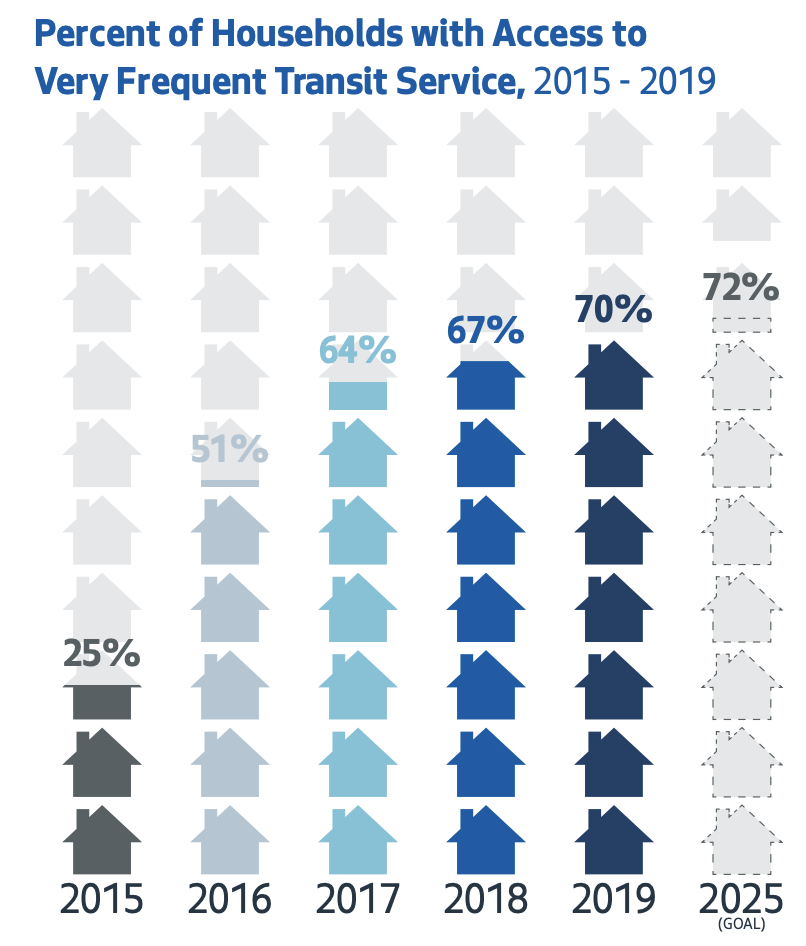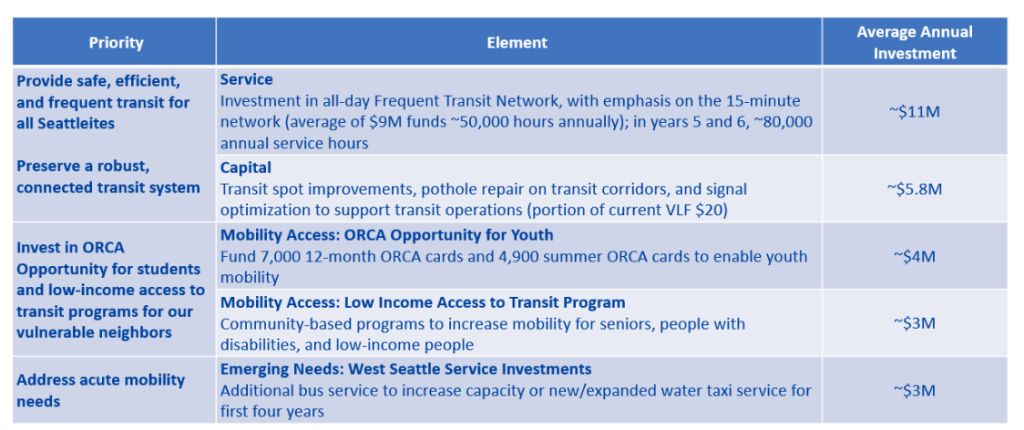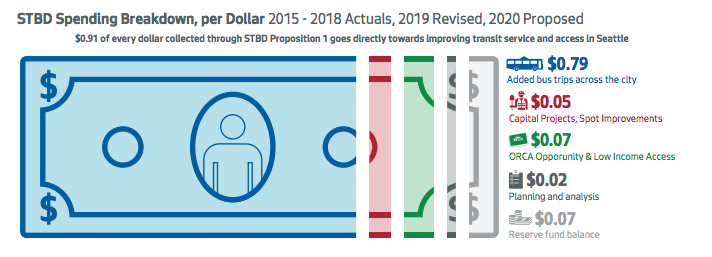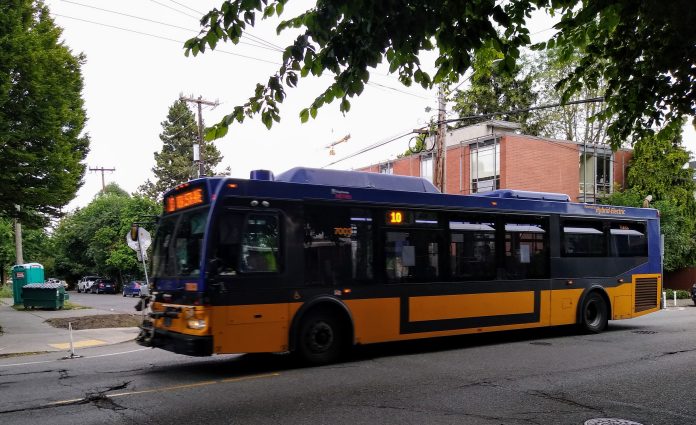Seattle Mayor Jenny Durkan has finally unveiled her proposal for replacing Seattle’s Transportation Benefit District, which currently funds a large segment of King County Metro’s overall bus network and is set to expire at the end of the year. We previewed what the proposal was likely to look like last week, as Councilmember Alex Pedersen announced that he would be chairing a Select Committee to approve the new proposal to the November ballot by early August.
The current measure consists of a 0.1% sales tax and a $60 car tab fee. Even with the constitutionality of statewide Initiative 976 still up-in-the-air, a car tab will not be part of the package this time, leaving only a 0.1% sales tax. Sales tax forecasts expect revenue to be way below pre-Covid levels for a long time. That combines to create a revenue stream that is expected to generate fewer than $30 million per year through 2024, compared to $56 million in projected revenue for 2020.
The proposal announced yesterday would allocate around $10 million yearly to running buses around the city, starting with around 50,000 annual hours of bus service in the first few years and scaling up to 80,000 in 2025 and 2026. Contrast that with around 350,000 annual hours of service that were funded by the transportation benefit district as of September of last year.

The current transportation benefit district has focused on improving the “very frequent” transit network, which means 10-minute service all-day (defined generally as 6am to 7pm) on weekdays. The proposed measure is a noticeable downgrade for supporting the “15-minute” transit network. Seattle had been on a path of expanding the 10-minute very frequent network to 72% of households by 2025.
The reason it will fund relatively few citywide bus trips compared to the previous proposal is that other programs are also competing for funding. ORCA Opportunity, which funds transit passes for students, and an additional program to fund transit passes for residents at income-restricted Seattle Housing Authority buildings, would continue, with no one currently receiving a free transit pass losing it. This will cost an estimated $7 million per year.

Paying for transit passes was not something that voters approved with the current transportation benefit district in 2014—that was approved later by the Seattle City Council when Metro could not scale up transit service fast enough and the program’s reserve fund began to grow. Funding free transit passes for those who need it is amazing, but what if it comes at the expense of the very transit network that it provides access to?
Spending transportation benefit district funds on capital improvements, like bus lanes and transit signals, was also something that the city council approved when reserve funds were high. But that too will continue to be a recipient of transportation benefit district dollars, to the tune of around $6 million per year.
Spot improvements to improve transit reliability, as well as pothole repair on transit routes and signal optimization, are all cited as being line-items that would receive those capital funds. The Seattle Department of Transportation’s (SDOT) core budget is expected to take a hit during the next few years, with the $900 million Move Seattle levy being used to supplant core general fund transportation spending. It’s hard to argue that these projects are a better use for transportation benefit district funding than bus hours.

Via to Transit, an on-demand shuttle service to light rail stations in the Rainier Valley, is one add-on pilot program that will be ending. The city council never authorized the service, going as far to publicly reject the proposal in 2018 when material changes were being made to the transportation benefit district. Over $3 million has been spent on the program, garnering little ridership.
Finally, the proposal includes a sizable chunk going to mitigation for the West Seattle bridge closure, around 20% to 25% of the entire revenue generated every year between 2021 and 2024. This is acknowledged as an equity issue, which it is. The West Seattle Bridge was built to bypass areas like Georgetown and South Park, where residents face some of the worst environmental pollution in the Seattle region, and as such experience some of the lowest life expectancies in Puget Sound. With the bridge closed, they also have to contend with a higher-than-normal amount of traffic detouring through their neighborhood to access alternative bridges over the Duwamish River.
It’s not clear exactly what the approximately $5 million per year between 2021 and 2024 would pay for at this point to mitigate those impacts. SDOT’s Ethan Bergerson told me, “we will continue working with our partners at King County Metro, the West Seattle Bridge Community Task Force, and people who live in West Seattle, High Point, Delridge, South Park, and Georgetown to determine these details.”
Presumably the West Seattle-related spending will include some capital improvements that blunt the impact of increased car traffic in the Duwamish Valley’s neighborhoods, as well as increased Water Taxi service.

During the middle of a pandemic that will have major center city employers asking their employees to work from home indefinitely is certainly a tricky time to estimate future transit ridership and plan a ballot measure to supplement service. But only planning to add back a fraction of the bus service that made the transportation benefit district so successful is undoubtedly short-sighted. Additional revenue for essential transit service is going to be needed to ensure the gains in transit ridership that Seattle saw since 2015 do not evaporate.
On Friday at 10am, the entire city council will meet to discuss this proposal. During the 2019 elections, almost all of the district councilmembers supported renewing and expanding the transportation benefit district. Now we will see if they are able to craft a proposal that is more bold than the one the Mayor has put forward.
Ryan Packer lives in the Summit Slope neighborhood of Capitol Hill and has been writing for the The Urbanist since 2015. They report on multimodal transportation issues, #VisionZero, preservation, and local politics. They believe in using Seattle's history to help attain the vibrant, diverse city that we all wish to inhabit. Ryan's writing has appeared in Capitol Hill Seattle Blog, Bike Portland, and Seattle Bike Blog, where they also did a four-month stint as temporary editor.



